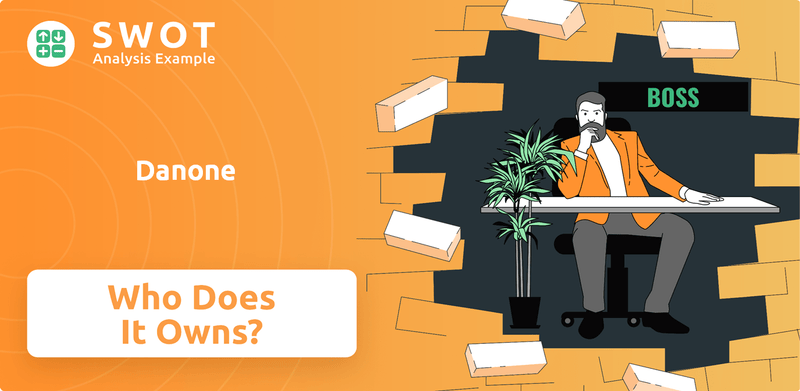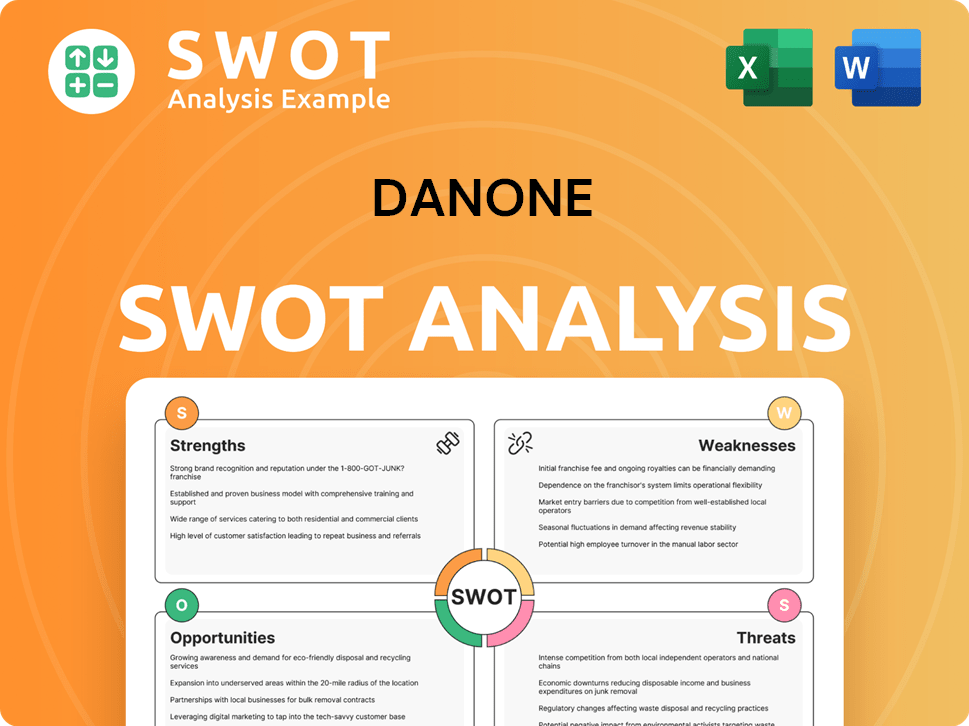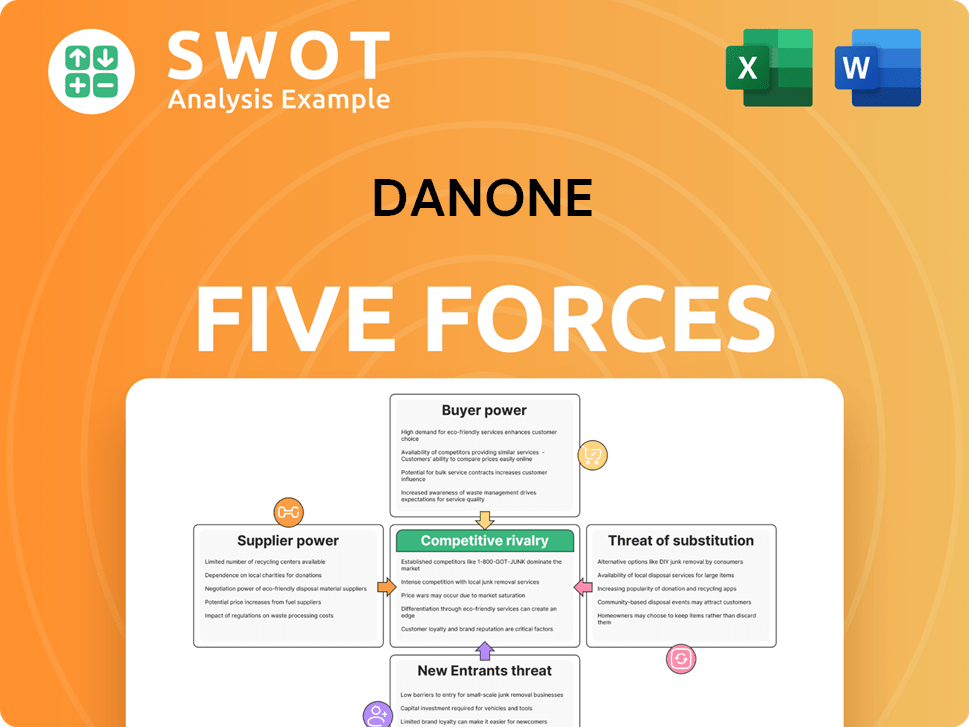Danone Bundle
Who Really Controls Danone?
Unraveling the Danone SWOT Analysis is key to understanding its strategic depth. Understanding the Danone ownership is crucial to grasping the company's future. The answer to "Who owns Danone company?" isn't just about shareholdings; it's about power, direction, and the forces shaping a global food and beverage giant.

From its humble beginnings in 1919 to its current status as a multinational corporation, Danone's history is a fascinating study in corporate evolution. The influence of Danone shareholders, institutional investors, and the public market has significantly shaped its trajectory. We'll explore the Danone parent company structure, its major investors, and how these elements influence its strategic decisions, including product innovation and global expansion.
Who Founded Danone?
The story of Danone's history begins with Isaac Carasso, who launched the company in Barcelona in 1919. The initial ownership structure was straightforward, with Carasso at the helm. His background as a doctor significantly influenced the company's focus on health and nutrition.
The name 'Danone' itself is a tribute to Isaac's son, Daniel Carasso, highlighting the family's central role. The company's early years were marked by private ownership and family control, setting the stage for its future growth. The company's early structure was a direct reflection of the founder's vision.
In 1929, Daniel Carasso expanded the business to France, further establishing the family's entrepreneurial spirit. For many years, the company remained a privately held, family-managed entity. Details about early investors or initial equity splits are not available, indicating a self-funded or closely-held structure during its early stages. The company's strategic direction was clear and consistent, thanks to its family-driven ownership.
During its initial phase, the Danone ownership was entirely private, with Isaac Carasso in control. The company's focus on health and nutrition was a key driver. Early expansion into France in 1929 by Daniel Carasso continued the family's vision.
- The company's early structure was self-funded, with no publicly known angel investors.
- Specifics about early agreements like vesting schedules are not available due to the private nature of the company.
- The family-driven ownership allowed for a consistent strategic direction.
- The company's early products were centered around health and nutrition.
Danone SWOT Analysis
- Complete SWOT Breakdown
- Fully Customizable
- Editable in Excel & Word
- Professional Formatting
- Investor-Ready Format

How Has Danone’s Ownership Changed Over Time?
The evolution of Danone's ownership structure is marked by its transition from a privately held entity to a publicly traded company. This shift, initiated through an initial public offering (IPO), broadened the investor base, allowing for participation from institutional investors, mutual funds, and individual shareholders. The company, now listed on Euronext Paris, has seen significant changes in its major shareholding over time, reflecting the dynamic nature of the financial markets and the influence of various investment strategies. Understanding the Danone company's ownership is crucial for grasping its strategic direction and financial performance.
The Danone parent company's ownership has been significantly impacted by the involvement of activist investors. The influence of major shareholders, particularly institutional investors and activist funds, has played a pivotal role in shaping the company's leadership and strategic decisions. For instance, in 2020-2021, calls from investment funds led to changes in the company's leadership. These shifts highlight the power of shareholders to influence corporate governance and strategic direction. The current ownership structure reflects a balance between institutional influence and the company's commitment to its 'Entreprise à Mission' status, emphasizing both economic and social objectives.
| Shareholder | Percentage of Shares (as of March 2024) | Type |
|---|---|---|
| Capital Research & Management Co. | 6.4% | Institutional |
| BlackRock, Inc. | 6.0% | Institutional |
| The Vanguard Group | 2.9% | Institutional |
| Norges Bank Investment Management | 2.7% | Institutional |
As of early 2024, Danone's ownership is primarily held by institutional investors. Capital Research & Management Co. and BlackRock, Inc. are among the largest institutional shareholders, holding 6.4% and 6.0% of the shares, respectively, as of March 2024. Other significant shareholders include The Vanguard Group and Norges Bank Investment Management. These institutional holdings represent a substantial portion of Danone's capital and influence corporate governance. This ownership structure has driven the company to refine its strategic focus, emphasizing profitable growth and shareholder returns. For more insights into the company's strategic approach, you can explore the Growth Strategy of Danone.
The ownership of Danone has evolved significantly since its IPO, with institutional investors now holding a major stake.
- Institutional investors like Capital Research & Management Co. and BlackRock, Inc. are key shareholders.
- Activist investors have influenced leadership and strategic decisions.
- The company balances shareholder returns with its 'Entreprise à Mission' commitment.
- Understanding Danone's ownership structure is vital for assessing its strategic direction.
Danone PESTLE Analysis
- Covers All 6 PESTLE Categories
- No Research Needed – Save Hours of Work
- Built by Experts, Trusted by Consultants
- Instant Download, Ready to Use
- 100% Editable, Fully Customizable

Who Sits on Danone’s Board?
The current Board of Directors at Danone plays a vital role in the company's governance, balancing the interests of various stakeholders. As of early 2025, the Board includes a mix of independent directors and individuals with significant industry experience. Antoine de Saint-Affrique serves as the Chief Executive Officer and a member of the Board. Gilles Schnepp holds the position of Chairman of the Board. This structure is designed to ensure objective oversight, a common practice in publicly traded companies.
The Board's composition reflects a diverse set of members. While specific board members directly representing major shareholders like Capital Research & Management Co. or BlackRock are not typically disclosed as 'representatives', these institutional investors exert considerable influence through their voting power during shareholder meetings. Their influence is particularly felt on matters such as director elections and executive compensation. The interplay between the Board, executive management, and major shareholders shapes decision-making and influences strategic direction, including the company's commitment to its 'Entreprise à Mission' status.
| Board Member | Title | Key Role |
|---|---|---|
| Antoine de Saint-Affrique | Chief Executive Officer | Oversees all aspects of the company's operations and strategy. |
| Gilles Schnepp | Chairman of the Board | Leads the Board and ensures effective governance. |
| Independent Directors | Various | Provide objective oversight and represent shareholder interests. |
Danone operates under a 'one-share-one-vote' structure, meaning each share of common stock generally grants one vote in shareholder decisions. The concentration of ownership among large institutional investors means their collective voting power significantly impacts strategic decisions and board appointments. Recent events highlight the dynamic interplay between the Board, executive management, and major shareholders. Understanding the Target Market of Danone can provide additional insights into the company's strategic direction.
Danone's ownership structure is primarily influenced by institutional investors. These large shareholders wield significant voting power. The 'one-share-one-vote' system ensures that voting rights are proportional to share ownership.
- Institutional investors hold a significant portion of Danone company stock.
- The Board of Directors is composed of a mix of independent and experienced members.
- Shareholder voting significantly impacts strategic decisions.
- The company's commitment to its 'Entreprise à Mission' status is a key factor.
Danone Business Model Canvas
- Complete 9-Block Business Model Canvas
- Effortlessly Communicate Your Business Strategy
- Investor-Ready BMC Format
- 100% Editable and Customizable
- Clear and Structured Layout

What Recent Changes Have Shaped Danone’s Ownership Landscape?
Over the past few years, the ownership structure of the company has seen shifts influenced by strategic initiatives and broader industry trends. Activist investors, such as Artisan Partners and Bluebell Capital Partners, pushed for changes, particularly in 2020 and 2021. These actions led to a review of the company's assets and a leadership transition, highlighting the impact of institutional investors on corporate direction. The company's commitment to its 'Entreprise à Mission' status positions it well to address investor concerns regarding environmental, social, and governance (ESG) factors.
In response to these pressures, the company has undertaken strategic divestments, including the sale of its stake in Russia in 2022. While specific share buybacks haven't been a primary focus, the company has concentrated on optimizing its capital structure and driving profitable growth. The company is focused on its 'Renew Danone' strategy, aiming for strong, sustainable, and profitable growth. The ongoing strategic adjustments and commitment to its purpose-driven model will continue to shape its ownership dynamics. Understanding the Marketing Strategy of Danone can also provide insights into the company's overall strategic direction.
| Metric | Value | Year |
|---|---|---|
| Market Capitalization (approx.) | €49 Billion | 2024 |
| Revenue (2023) | €27.6 Billion | 2023 |
| Institutional Ownership (approx.) | Around 60-70% | 2024 |
The rise of activist investors remains a significant trend, pushing companies to be more agile and transparent. The company’s current ownership structure is primarily composed of institutional investors holding a significant portion of the shares. The company's financial performance and market capitalization reflect its position in the global food and beverage industry. The company's focus on sustainable growth and its purpose-driven model will continue to shape its ownership dynamics in the future.
Recent developments include strategic divestments and responses to activist investor pressures. The company is focused on optimizing its capital structure and driving profitable growth. These changes reflect broader industry trends and the company's strategic goals.
Major shareholders include large institutional investors. The ownership structure is primarily influenced by institutional investors. This structure reflects the company's strategic direction and market position.
The company's 'Entreprise à Mission' status positions it well to address ESG concerns. Increased focus on environmental, social, and governance factors is a key trend. This focus influences investor decisions and corporate strategy.
The company is focused on its 'Renew Danone' strategy for sustainable growth. Strategic adjustments and purpose-driven models will shape ownership dynamics. The company aims for strong, sustainable, and profitable growth.
Danone Porter's Five Forces Analysis
- Covers All 5 Competitive Forces in Detail
- Structured for Consultants, Students, and Founders
- 100% Editable in Microsoft Word & Excel
- Instant Digital Download – Use Immediately
- Compatible with Mac & PC – Fully Unlocked

Related Blogs
- What are Mission Vision & Core Values of Danone Company?
- What is Competitive Landscape of Danone Company?
- What is Growth Strategy and Future Prospects of Danone Company?
- How Does Danone Company Work?
- What is Sales and Marketing Strategy of Danone Company?
- What is Brief History of Danone Company?
- What is Customer Demographics and Target Market of Danone Company?
Disclaimer
All information, articles, and product details provided on this website are for general informational and educational purposes only. We do not claim any ownership over, nor do we intend to infringe upon, any trademarks, copyrights, logos, brand names, or other intellectual property mentioned or depicted on this site. Such intellectual property remains the property of its respective owners, and any references here are made solely for identification or informational purposes, without implying any affiliation, endorsement, or partnership.
We make no representations or warranties, express or implied, regarding the accuracy, completeness, or suitability of any content or products presented. Nothing on this website should be construed as legal, tax, investment, financial, medical, or other professional advice. In addition, no part of this site—including articles or product references—constitutes a solicitation, recommendation, endorsement, advertisement, or offer to buy or sell any securities, franchises, or other financial instruments, particularly in jurisdictions where such activity would be unlawful.
All content is of a general nature and may not address the specific circumstances of any individual or entity. It is not a substitute for professional advice or services. Any actions you take based on the information provided here are strictly at your own risk. You accept full responsibility for any decisions or outcomes arising from your use of this website and agree to release us from any liability in connection with your use of, or reliance upon, the content or products found herein.